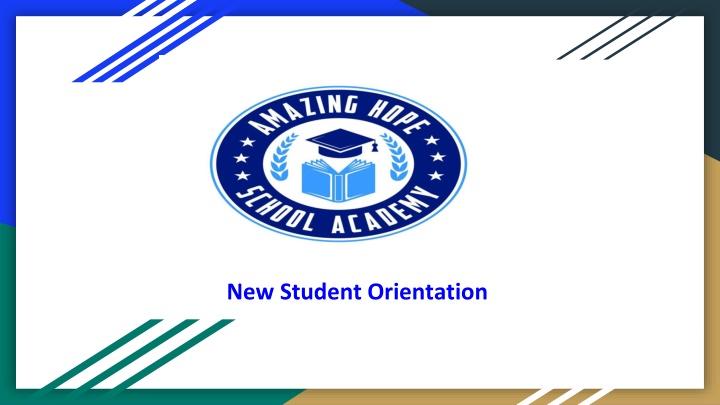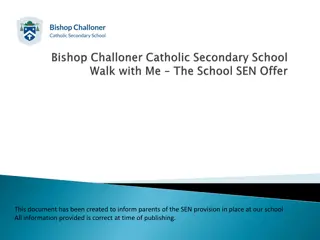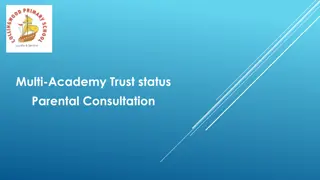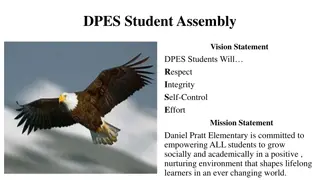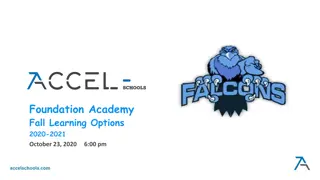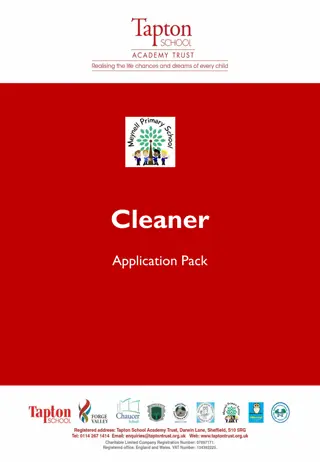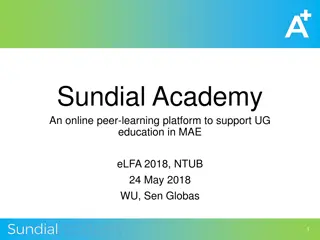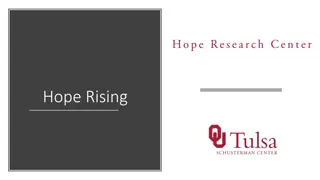The Amazing Hope School Academy: Empowering Students with Special Needs
The Amazing Hope School Academy (AHSA) is a non-profit Christian school in Apopka providing a nurturing and inclusive learning environment for children with special needs, offering a unique educational approach based on the Glasser Quality School (GQS) model. AHSA focuses on individual success through Choice Theory, encouraging self-directed learning, faith-based teaching, and fostering joy in education. The school's mission is to guide students towards their life goals and prepare them to be active contributors to society.
Download Presentation

Please find below an Image/Link to download the presentation.
The content on the website is provided AS IS for your information and personal use only. It may not be sold, licensed, or shared on other websites without obtaining consent from the author.If you encounter any issues during the download, it is possible that the publisher has removed the file from their server.
You are allowed to download the files provided on this website for personal or commercial use, subject to the condition that they are used lawfully. All files are the property of their respective owners.
The content on the website is provided AS IS for your information and personal use only. It may not be sold, licensed, or shared on other websites without obtaining consent from the author.
E N D
Presentation Transcript
SCHOOL WIDE CHOICES A Aspiring, Acceptance Our work is accepted to be aspiring! H Helpful, Honorable I am helpful and honorable to God, others, and myself. S-- Self-Evaluate and Self-Control I self-evaluate how my body talks, feelings, thinking and acting to help me and others. A Always Pray for Wisdom and be Mindful I have Faith and am being mindful leading to my success AHSA IS THE NEW MEANING OF THE WORD HOPE
The Amazing Hope School Academy (AHSA) is a school for children with special needs, kindergarten to high school (or 4 -22 years old) and those who will be homeschooled to learn. AHSA is a non-profit Christian school, and it will be the first school in Apopka offering the community a school where all children are accepted, and that they are in a place where learning is fun! AHSA is like other schools that focuses on an individual s success; yet it is different, because using the GQS model, everyone has choices on how she or he wants to learn. The curriculum is integrated into many aspects of life, and its functionality. The need for spiritual choices of living and learning lead to having a joyful place to go to, not just educationally, AHSA will teach all students the value of what they truly want in their life, rather than dictating them what they should have in their lives.
School Overview Mission Statement: To promote a nurturing, learning experience in which students are self-directed learners toward their life goals for success leading to become contributors in the community. Vision Statement: Amazon Hope School Academy (AHSA) will use the Glasser Quality School (GQS) model as a guide to create a Christian school that uses Choice Theory to support learning, life goals, and relationships based on faith, safety, love, respect, and will be known as a joyful place for learning.
Comparative Analysis The competitive schools that currently exist in this industry that would be comparable to AHSA all count with the same ESE programs with the exception of key programs that AHSA will be offering. These schools do not count with: - - - - - - - - Before and after school program, Transition to the community program Family advocacy Bilingual/ESOL Services Teenage Parenting Training Employment Training Social Emotional Learning One-Stop Resource Center
What is a Glasser Quality School? In a Glasser Quality School, students and teachers are taught Choice Theory to reach a common ground in establishing a supportive, caring environment and in building healthy relationships that contribute to school success. Classroom management and teaching techniques based on coercion are replaced by Choice Theory techniques that shift the definition of and desire for success to the student. Teachers and administration become collaborative leaders empowering students to reach their highest potential. Families are also encouraged to learn Choice Theory so home and school support the student in compatible ways.
- The aim of quality schools is to present education from a different set of lenses. Most schools follow a traditional approach to teaching, whereby the learning is very much teacher centered, focused on the passing on of information and then assessing that information. Dr Glasser describes the quality world as a "personal picture album" of all the people, things, ideas, and ideals that we have discovered increase the quality of our lives. While the basic human needs are the general motivation for all human behaviour, the quality world is the specific motivation. -
What is Choice Theory Choice Theory is based on the simple premise that every individual only has the power to control themselves and has limited power to control others. Applying Choice Theory allows one to take responsibility for one's own life and at the same time, withdraw from attempting to direct other people's decisions and lives. Negative behaviors reduce in frequency and intensity, relationships strengthen and satisfaction in life increases.
Basic Needs According to the concepts of Choice Theory, all behavior is purposeful. Everything you do is your best attempt to get what you want, at that point in time with the information available to you. Getting what you want ultimately satisfies one or more of your five basic needs, which provides the motivation for all you do. 1. Survival 2. Love & Belonging 3. Power 4. Fun 5. Freedom
Survival This is a physiological need encompassing everything you need to sustain life, such as health, shelter and nourishment. Reproductive sex includes survival of the species. The psychological component to this need involves feeling safe and secure.
Love & Belonging The need for Love & Belonging includes the drive to be connected with others, such as friends, family, intimate partners, co-workers, pets and the groups you affiliate with.
Power This need involves the desire to matter, make a difference, achieve, be competent, recognized and respected. It includes self-esteem and a desire to leave a legacy.
Fun This need encompasses pleasure, play, humor, relaxation and relevant learning.
Freedom The need for freedom is about having choices, being independent and autonomous. Freedom is about being able to move freely without restriction. Creativity is a part of this need, too..
Relationship Habits Reality Therapy and Choice Theory were developed as a way to help people take control of, and be responsible for, their behavior. The basic tenet of Choice Theory is to promote self-control so that individuals can increase their ability to make and act on responsible choices. Choice Theory endorses the adoption of seven Connecting Relationship Habits that can be used in all your relationships. When adopted, practicing the concepts from Choice Theory becomes a way of life. Connecting Relationships Habits: 1. 2. 3. 4. 5. 6. 7. Supporting Encouraging Listening Accepting Trusting Respecting Negotiating Differences
The opposite of the Connecting Relationship Habits is the seven Disconnecting Habits which are based on external control. These habits lead to the breakdown of relationships. Being disconnected can lead to many of the problems facing human beings. Individuals use the seven Disconnecting Habits to control people. Utilizing these habits usually leads to misunderstandings and resentment. 7 Disconnecting Habits 1. Criticizing 2. Blaming 3. Complaining 4. Nagging 5. Threatening 6. Punishing 7. Bribing, Rewarding to Control
In order to have a healthy relationship, it is very important to focus on our own behavior. Having healthy relationships means supporting, encouraging, accepting, trusting, respecting, negotiating differences, and listening to each other. Just as happiness is a choice, a happy relationship is also a choice. You get to choose whether you utilize Connecting or Disconnecting Habits.
The Ten Axioms of Choice Theory 1. 2. 3. 4. 5. The only person whose behavior you can control is our own. All we can give or get from other people is information. All long-lasting psychological problems are relationship problems. The problem relationship is always part of our present lives. What happened in the past that was painful has a great deal to do with what we are today, but revisiting this painful past can contribute little or nothing to what we need to do now: improve an important, present relationship. We are driven by five genetic needs: survival, love and belonging, power, freedom, and fun. We can satisfy these needs only by satisfying a picture or pictures in our Quality Worlds. All we can do from birth to death is behave. All behavior is Total Behavior and is made up of four inseparable components: acting, thinking, feeling and physiology. All Total Behavior is designated by verbs, usually infinitives and gerunds, and named by the component that is most recognizable. 10. All Total Behavior is chosen, but we have direct control over only the acting and thinking components. 6. 7. 8. 9.
Quality World Your Quality World is a special place in your mind, where you store the mental pictures or representations of everything you want. The people, places, things, values and beliefs that are important to you reside there. The only thing necessary for admittance into the Quality World is that it must feel very good to you and meets your basic needs. Quality World pictures are unique and specific for each person. It is possible to have conflicting Quality World pictures, which can create a quandary. If you could live in your Quality World, life would be perfect, but unfortunately, you don t get to live there.
Perceived World Choice Theory explains that the only way you can experience the real world is through your perceptual system. Information from the real world first comes to you through your five senses: sight, hearing, taste, smell and touch. Next, these sensations pass through your perceptual system, beginning with your Total Knowledge Filter, which represents everything you know or have experienced in life. When information passes through your Total Knowledge Filter, one of three things happens: 1. 2. You decide that the information is not meaningful to you and the perception stops there, You do not immediately recognize the information, but believe it may be meaningful, so you have some incentive to investigate further, The information is meaningful to you and therefore passes through the next filter, the Valuing Filter. 3.
When information passes through the Valuing Filter, you place one of three values on it. 1. If the information is pleasurable, you place a positive value on it. 2. If it is painful, you place a negative value on it. 3. If it s neither positive nor negative, then the information remains neutral. Because you have different information, experiences and values, your perception of the world can be vastly different from someone else s. It is interesting and curious when that happens. You tend to believe that since you experienced the information, or real world, with your senses, what you perceived must be right and true. It is difficult to understand that someone else may see, hear, taste, smell and feel it differently.
Your Perceived World is how you see things, it is Quite subjective based on your culture, family of origin, education, experience, gender, age, etc. Unique Subject to constant change (new information, new experiences = new perceptions) Frequently inaccurate, but it feels totally accurate to you
Comparing Places The Comparing Place is where you are constantly comparing what you want (your Quality World pictures) with what you have (your Perceived World). When the two match fairly well, you feel good. When there is a mismatch, you feel some frustration, depending on how important the Quality World picture is to you. That frustration signal is felt as an urge to behave in a way that will help you get more of what you want. Choice Theory represents this Comparing Place with a set of scales. When your scales are in balance because you have what you want, you tend to continue what you ve been doing to keep it. When your scales get out of balance because you don t have what you want, ideally you search for behavior that will work more effectively.
Internal vs External Control Psychology One of the major premises of Choice Theory is that All behavior is purposeful. That is, all your behavior is your best attempt at the time, given the information at your disposal, to get what you want to more effectively meet your needs. Another way of putting it is all your behavior is an attempt to make the real world look like the pictures you have in your Quality World. The practice of Choice Theory involves understanding the choices you make to meet your needs and self-evaluating whether those behaviors really are helping you achieve what you want in a way that doesn t stop others from doing the same. The practice of Choice Theory in your life involves a transformation in your mindset and behavior from external control psychology, the belief that your experiences and behaviors are determined by outside forces: luck, circumstances, other people and external factors, to one of internal control psychology: the belief that you are responsible for your choices and their resulting consequences.
Evaluating the difference between what you want in your Quality World and what you have in your Perceived World motivates you to take action. Choice Theory practice provides the knowledge and skills for you to let go of the myth of external control and reduce your use of the Disconnecting Habits, to instead understand and accept internal control, while implementing the Connecting Habits. This moves you closer to what you want in your Quality World: better relationships and a more satisfying life.
Classrooms With and Without CT With CT & 10 Axioms Internal Locus of Control: Without CT & 10 Axioms External Locus of Control: Here are your choices for completing our assignment today: Your assignment today must be completed in the following manner .if you don t complete it, it will be homework You seem to be struggling with the assignment. May I help you or would you prefer to work with another student (in a breakout room)? You aren t getting it. I ll see you after school (during my zoom office hours). I know it s difficult to save important conversations for later, but we d appreciate it if everyone was quiet so we could continue the lesson (please mute yourself &/or use the chat box). You seem to have a lot to say, why don t you share with all of us (I ll mute everyone else)!!
Glasser Self- Evaluating Strategy S- Show E- Explain how you did it S-Self-Evaluate your work I-Identify ways to Improve your work R- Repeat the self-evaluation & improvement process until you believe it is Quality
Glasser Quality Schools: Emphasized Increasing students responsibility for their own learning and success, strengthening relationships among peers, teachers, students and families to build thriving, healthy learning communities.
Children want the same things we want. To laugh, to be challenged, to be entertained, and delighted. DR. SEUSS
Documents Needed Enrollment Form Student s Birth Certificate Florida 680 Immunization Form Florida Physical Form Withdrawal form from previous school Final Transcripts/Withdrawal Grades/Report Card from previous school Current IEP/ eligibility documents for initial eligibility & reevaluation documents Current 504 Plan (if applicable) Current Bill Copy of Parent/Guardian ID Proof of Scholarship Eligibility Current Lease/Homestead Card/Deed/Tax Appraisal Form Custody Paperwork- Court Docs/Educational Guardianship (if applicable)
Diagnostics After this orientation, students will undergo a Reading and Math Diagnostic to assess their academic level. This is very important for placement, and to meet the academic needs of every student. Duration: 1-2 hours
Start Date Your student will start immediately upon receiving all documentations for enrollment. School Hours Mondays, Tuesdays and Thursdays: 8:30 - 3:30pm Wednesdays - 8:30am - 2:00pm Friday s - 8:30am - 1:00pm There will be a Parent Meeting the last Friday of the month, date and time will be shared via newsletter and/or email. All Parents/Guardians are encouraged to attend to give you an overview of what is AHSA all about. You are an integral part of our students success!!!
Time Monday Tuesday Wednesday Thursday Friday Morning Work/Daily Journal Morning Work/Daily Journal Morning Work/Daily Journal Morning Work/Daily Journal 8:30-9:00am Morning Work/Daily Journal 9:00 - 9:15am Class Meeting Class Meeting Class Meeting Class Meeting Class Meeting 9:15 - 9:30am Snack Snack Snack Snack Snack 9:30 - 10:15am Reading/ELA Reading/ELA Reading/ELA Reading/ELA Reading/ELA 10:15 - 11:00am Mathematics Mathematics Mathematics Mathematics Mathematics 11:00 - 11:45am Science Social Studies SEL/Character Education Science Social Studies 12:00 - 12:30pm Lunch Lunch Lunch Lunch Lunch 12:30 - 1:15pm SEL/Character Education SEL/Character Education Bible Class Dance Make Up Reading 1:15-2:00pm Bible Class Bible Class American Sign Language Bible Class Staff Training Early Release @ 1pm/Staff Training 2:00 - 3:00pm American Sign Language American Sign Language Early Realease @ 2:00pm American Sign Language
School Uniform and Dress Code - - All students will wear a Navy Blue school polo (20/polo) All students will wear shorts or long pants (khaki s, black or blue) If girls would like to wear skirts, they need to be above the knees and have shorts underneath All students will wear closed-toe shoes at all times to school - -
Lunch and Snacks - - - - - All students should bring their lunch daily All students should have a daily healthy snack All students should bring a bottle of water Please do not bring any candy or gum to school Please label your students items so they do not get mixed up with other students items
Student Pick Up Policy All students should be picked up by their parent/guardian If the parent or guardian cannot pick up their student, the person picking up the student must be in our system. We will not accept permission by phone or email. Parent/Guardian must inform us of a change of a person picking up the guardian via the Quickschools Portal or adding them personally to their school file. The person to pick up the child must be at least 18 years old and must show a picture/valid ID at the time of pick up Students should be picked up everyday on time. If you are running late for an unforeseen reason, please call the school and let us know asap. - - - - -
A teacher can give a student information and help him or her use that information, but the teacher can t do the work for the student. Dr. William Glasser
